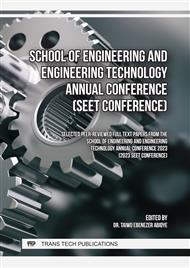[1]
Folorunso, D. O., Aramide, F. O., Olubambi, P. and Borode, J. O. (2015). The Effect of Firing Temperatures on the Performance of Insulating Firebricks Containing Different Proportions of Alumina and Sawdust. Journal of Minerals and Materials Characterization and Engineering, 3, 309-317.
DOI: 10.4236/jmmce.2015.34033
Google Scholar
[2]
Obidiegwu, E. O., Ochulor, E. F. and Mgbemere, H. E. (2019). Model for Predicting Mix Formulation in the Production of Insulating Refractory Bricks Using Nigerian Fire-Clays and Coconut Shell. Nigerian Journal of Technology (NIJOTECH). 38(3): 654-659.
DOI: 10.4314/njt.v38i3.16
Google Scholar
[3]
Adediran, A. A., Balogun, O. A., Akinwande, A. A., Adesina, O. S. and Bello, O. S. (2021). Influence of Waste Glass and Particulate Coconut Shells as Reinforcement Materials in the Production of Masonry Bricks. Journal of American Society of Civil Engineers. 33(10): 101-113.
DOI: 10.1061/(asce)mt.1943-5533.0003903
Google Scholar
[4]
Ibrahim, J. E. F. M., Tihtih, M. and Gömze, L. A. (2021). Environmentally-friendly Ceramic Bricks made from Zeolite-Poor Rock and Sawdust. Construction and Building Materials. 297: 123715
DOI: 10.1016/j.conbuildmat.2021.123715
Google Scholar
[5]
Folorunso, D.O. (2015). The Purification and Adaptation of Termite Hill Clay for Furnace Lining by Graphite and Rice Husk Addition. American Journal of Engineering Research (AJER). 4(5): 08-15.
Google Scholar
[6]
Olalere, A. A., Yaru, S. S. and Dahunsi, O. A. (2019). Evaluation of the Chemical and Thermo-physical Properties of Locally Aggregated Kaolin-Based Refractory Materials. Journal of Mechanical Engineering and Sciences. 13(1): 4743-4755.
DOI: 10.15282/jmes.13.1.2019.27.0397
Google Scholar
[7]
Owoeye, S. S., Abegunde, S. M., Folorunso, D. O., Adigun, B. O. and Kingsley, U. (2021). Microstructure, Phase and Physical Evaluation of Non-bioactive Wollastonite Glass – Ceramic Prepared from Waste Glass by Sintering Method. Open Ceramics. 5: 100062.
DOI: 10.1016/j.oceram.2021.100062
Google Scholar
[8]
Neeraj, K. and Chandra, M. (2021). Basics of Clay Minerals and Their Characteristic Properties [Online First], IntechOpen, Available from: https://www.intechopen.com/online-first/76780
Google Scholar
[9]
Odewale1, I. O., Ameh, E. M. and Amaakaven, V.T.D. (2018). Comparative Analysis of Insulating Brick Produced from Locally Sourced Clays and Combustible Materials. Journal of Science, Engineering Development, Environment Technology (JOSEDET). 1(1): 45-56
Google Scholar
[10]
Balogun, O. A., Akinwande, A. A. Adediran, A. A., Ikubanni, P. P., Shittu, S. A. and Adesina, O. S. (2020). Experimental Study on the Properties of Fired Sand–Clay Ceramic Products for Masonry Applications. Journal of Materials in Civil Engineering. 33(2): 1-12.
DOI: 10.1061/(asce)mt.1943-5533.0003532
Google Scholar
[11]
Folorunso, D. O., Aribo, S. and Olaniran, O. (2015). Performance Evaluation of Insulating Firebricks Produced from Hydrometallurgically Purified Termite Hill Clay Reinforced with Alumina. American Journal of Engineering Research (AJER). 4(5): 01-07.
Google Scholar
[12]
Falodun, E. O., Folorunso, D. O. and Borode, J. O. (2017). Investigating the Effects of High Alumina Cement and Silica Sand on the Suitability of Ikere Ekiti Clay for Refractory Applications. American Journal of Engineering Research. 6 (6): pp.24-28.
Google Scholar
[13]
Folorunso, D. O. (2018). Characterization and Value Enhancement of Some Nigerian Refractory Materials for Thermal Insulation. IOSR. Journal of Mechanical and Civil Engineering (IOSR- JMCE). 15 (3): 79–86.
Google Scholar
[14]
Odewole, P. O. and Folorunso, D. O. (2020): Fabrication of a Porous Ceramic Material Suitable for Cost-effective Thermal Insulation of Buildings. International Journal of Engineering and Manufacturing. 5: 45-56.
Google Scholar
[15]
Folorunso, D. O., Akinwande, A. A. and Balogun, O. A. (2021). Property Evaluation and Compliance Level Analysis of Glass Wastes Reinforced Ceramic Composites for Masonry Applications. International Journal of Advanced Academic Research: 7(5): 1-14
DOI: 10.46654/ij.24889849.e7305
Google Scholar
[16]
Folorunso, D. O. and Akinwande, A. A. (2021). Influence of Wood Saw Dust and Waste Glass Admixture on Selected Properties of Fired Clay Bricks for Masonry. Journal of Engineering and Engineering Technology. 15(1): 104-116.
DOI: 10.51459/futajeet.2021.15.1.269
Google Scholar
[17]
Nathan, C. (2020). Effect of Saw Dust, Rice Husk, and Groundnut Shell on Properties of Mubi Vimtim Clay in Adamawa State, Nigeria. IOP Conf. Series: Materials Science and Engineering. 912: 052010
DOI: 10.1088/1757-899x/912/5/052010
Google Scholar
[18]
Gowtham, R., Manikanda, P. S., Gowtham, M. and Ramasubramani, R. (2021). A Review on Utilization of Waste Glass in Construction Field. IOP Conference Series: Materials Science and Engineering. 1130: 012010.
DOI: 10.1088/1757-899x/1130/1/012010
Google Scholar
[19]
Nonthaphong, P. Siwadol, K. and Prinya, C. (2016). Utilization of Waste Glass to enhance Physical-Mechanical Properties of Fired Clay Brick. Journal of Cleaner Production. 112: 3057-3062.
DOI: 10.1016/j.jclepro.2015.10.084
Google Scholar
[20]
Kenneth, O. I. and Uzodimma, U. O. (2021). Evaluation of the Compressive Strength of Bamboo Culms under Node and Internode Conditions. Saudi Journal of Civil Engineering. 5(8): 251-258.
Google Scholar
[21]
ASTM (2018). Standard Test Method for Drying and Firing Shrinkages of Ceramic Whiteware Clays. ASTM C326-09. West Conshohocken, PA: ASTM
DOI: 10.1520/c0326-09
Google Scholar
[22]
Aramide, F. O., Adepoju, O. D., Adediran, A. A. and Popoola, A. P. (2019). Studies on the combined effects of titania and silicon carbide on the phase developments and properties of carbon-clay based ceramic composite. Cogent Engineering. 6 (1): 203-217
DOI: 10.1080/23311916.2019.1584938
Google Scholar
[23]
Guo, X., Cheng, S., Cai, W., Zhang, Y. and Zhang, X. (2021). A Review of Carbon-based Thermal Interface Materials: Mechanism, Thermal Measurements and Thermal Properties, Materials & Design. 209: 109936
DOI: 10.1016/j.matdes.2021.109936
Google Scholar
[24]
Li, S., Yang, X., Hou, J. and Du, W. (2020). A Review on Thermal Conductivity of Magnesium and its Alloys, Journal of Magnesium and Alloys. 8(1): 78-90.
DOI: 10.1016/j.jma.2019.08.002
Google Scholar
[25]
William, O, Florence, M. D. and Bosco, O. (2019). Effect of Quartz Particle Size on Sintering Behavior and Flexural Strength of Porcelain Tiles Made from Raw Materials in Uganda. Journal of Material Science. Vol. 5. P. 3.
DOI: 10.19080/jojms.2018.05.555661
Google Scholar
[26]
Srisuwan, A. and Phonphuak, N. (2020). Physical Property and Compressive Strength of Fired Clay Bricks Incorporated with Paper Waste. Journal of Metals, Materials and Minerals. 30(1): 103-108.
DOI: 10.55713/jmmm.v30i1.598
Google Scholar
[27]
Kruszelnicka, W., Chen, Z. and Ambrose, K. (2022). Moisture-Dependent Physical-Mechanical Properties of Maize, Rice, and Soybeans as Related to Handling and Processing. Materials. 15(24): 8729.
DOI: 10.3390/ma15248729
Google Scholar


